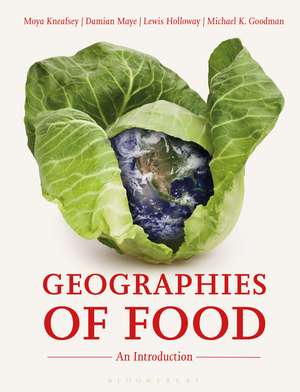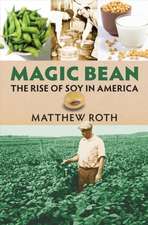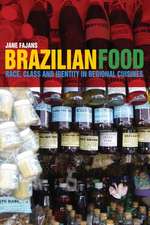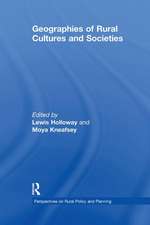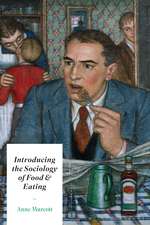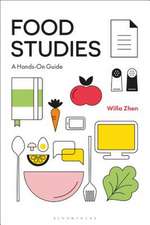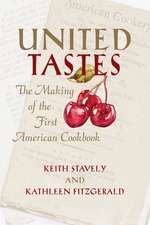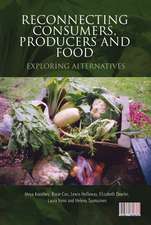Geographies of Food: An Introduction
Autor Moya Kneafsey, Damian Maye, Lewis Holloway, Professor Michael K. Goodmanen Limba Engleză Hardback – 10 feb 2021
| Toate formatele și edițiile | Preț | Express |
|---|---|---|
| Paperback (1) | 226.26 lei 3-5 săpt. | +67.68 lei 6-12 zile |
| Bloomsbury Publishing – 10 feb 2021 | 226.26 lei 3-5 săpt. | +67.68 lei 6-12 zile |
| Hardback (1) | 606.19 lei 3-5 săpt. | |
| Bloomsbury Publishing – 10 feb 2021 | 606.19 lei 3-5 săpt. |
Preț: 606.19 lei
Preț vechi: 824.20 lei
-26% Nou
Puncte Express: 909
Preț estimativ în valută:
115.99€ • 121.75$ • 96.28£
115.99€ • 121.75$ • 96.28£
Carte disponibilă
Livrare economică 21 martie-04 aprilie
Preluare comenzi: 021 569.72.76
Specificații
ISBN-13: 9780857854575
ISBN-10: 0857854577
Pagini: 368
Ilustrații: 65 colour illus
Dimensiuni: 189 x 246 x 26 mm
Greutate: 0.95 kg
Editura: Bloomsbury Publishing
Colecția Bloomsbury Academic
Locul publicării:London, United Kingdom
ISBN-10: 0857854577
Pagini: 368
Ilustrații: 65 colour illus
Dimensiuni: 189 x 246 x 26 mm
Greutate: 0.95 kg
Editura: Bloomsbury Publishing
Colecția Bloomsbury Academic
Locul publicării:London, United Kingdom
Caracteristici
Brings the subject alive for students, with up-to-date real life case studies and examples covering current food issues in the media such as rising food/energy prices to the obesity epidemic to food in schools to biotechnology
Notă biografică
Moya Kneafsey is Professor of Human Geography, Food, and Local Development at the Centre for Agroecology, Water, and Resilience at Coventry University, UK.Damian Maye is Professor of Agri-Food Studies at the Countryside and Community Research Institute, University of Gloucestershire, UK.Lewis Holloway is Professor of Human Geography at the University of Hull, UK.Michael K. Goodman is Professor of Geography at the University of Reading, UK.
Cuprins
ContentsList of figuresList of tablesList of boxesList of activitiesInsightsPrefaceAcknowledgementsDedicationPart 1: The Place of FoodChapter 1: Introducing Geographies of Food 1.1 Introduction1.2 What are food geographies?1.2.1 Multiple food meanings1.2.2 Food, place, space and scale1.2.3 Mobilities and transformation: power and control1.3 Geographical imaginations and food's geographies1.4 Structure of the bookChapter 2: Food and Place Identity 2.1 Introduction2.2Making food and making places: landscapes, nations and labour2.3 Moving food and making places: placing and displacing2.3.1 Placing food: the case of 'terroir'2.3.2 Displacing and placing food: migrant cuisines2.3.3 Placing diets2.4 Summary2.5 Further readingPart 2: Geographies of Food Production, Transformation and ConsumptionChapter 3: Geographies and Politics of Agricultural Production3.1 Introduction3.2 Geographies of food production: a global perspective3.2.1 A global typology of primary food production systems3.2.2 Overcoming the land-bias: the role of fisheries and marine management3.2.3 Back to the land: global levels of food production3.2.4 Geographical distribution of agricultural land3.3 Agro-food commodity chains: product sector geographies3.3.1 Cereals production3.3.2 Fruit and vegetables3.3.3 Meat and the changing chicken3.3.4 Spatial concentration, newly agriculturalising economies and relational assemblages3.4 Producing food in the city: urban agriculture3.5 Agricultural policy: political geographies of food production3.5.1 The US Farm Bill3.5.2 The Common Agricultural Policy (CAP)3.5.3 Comparing the US Farm Bill and the CAP3.6 Summary3.7 Further readingChapter 4: What Happens to Food: Geographies of Mobility and Transformation4.1 Introduction4.2 Mobility and transformations: geographies and relationships4.3 Transforming agriculture and food under capitalism: the agrarian question4.4 Liberalising food mobility: global trade policy and global food regimes4.5 Government intervention, global food governance and free trade4.5.1 From protectionism to free trade4.5.2 Trading blocs and subsidy debates4.5.3 Anti-politics and trade disputes 4.6 Global food trading: mobilising High Value Foods (HVFs)4.7 'Big Food': transforming and industrialising food4.8 Working in farming and food processing: the human cost4.9 Wasting food in industrialised food systems4.10 Summary4.11 Further readingChapter 5: Eating Geographies: The Spaces and Cultures of Food Consumption5.1 Introducing the geographies of eating5.2 The shifting geographies of food consumption5.3 Food's cultural geographies: eating space(s), places and connections5.3.1 The spaces of food: the foodscapes of acquisition and access5.3.2 The cultural spaces of food: the city, home and eating on the run5.3.3 Eating the cosmopolitan city5.3.4 Home cooking and eating5.3.5 Eating bodies: making spatial and cultural connections through identities5.4 Eating geographical politics and ethics5.4.1 Vegetarianism, veganism and low carbon diets5.4.2 Food provenance: knowing your food5.5 Summary: eating space, place and scale5.6 Further readingPart 3: Geographies of Food Crisis and ResponseChapter 6: Food Systems in Crisis? The New Food Insecurity6.1 Introduction6.2 The contours of the world food crisis6.2.1Food prices and the 2007-08 price spike6.3 The new food security debate6.4 Explaining the 2007-2008 food price crisis: the new fundamentals 6.4.1Climate change and food insecurity6.5 Financial speculation and the food crisis6.5.1 Financial markets and agricultural derivatives6.5.2 Food speculation, food prices and food security6.6 Other critical interpretations of the food crisis and food insecurity6.7 Summary6.8 Further readingChapter 7: The Fight against Hunger and Malnutrition in the Majority World7.1Introduction7.2 The scale and geography of hunger and malnutrition in the Majority World7.2.1 Defining hunger and malnutrition7.2.2. Where do hunger and malnutrition occur?7.3 Causes of hunger and malnutrition in the Majority World 7.3.1 Poverty, Inequality and Conflict 7.3.2 International structural inequalities7.4 The international response to hunger and malnutrition: from Green Revolution to the Sustainable Development Goals7.4.1 The Green Revolution7.4.2 The World Food Conference and the World Food Summits 7.4.3 The Millennium Development Goals7.4.4 The Sustainable Development Goals7.5From corporate power to people power: the rise of food sovereignty7.5Summary7.6Further readingChapter 8: Food Insecurity Amidst Wealth8.1 Introduction8.2 Food insecurity in the 21st Century: scale, causes and consequences8.2.1 What is food insecurity in rich countries?8.2.2 The scale of food insecurity8.2.3 The experience of food insecurity8.2.4 Causes of food insecurity: Poverty, deprivation and food deserts2.4.1 Poverty and deprivation2.4.2 Food deserts8.3 Solutions to food insecurity8.3.1 Charitable food aid and the role of corporations 8.3.2 The right to food 8.3.3 Food sovereignty movements in wealthy countries8.3.4 The movement for food justice8.4. Summary8.5 Further readingChapter 9 Reconnecting Consumers, Producers and Food 9.1 Introduction9.2 AFNs: definition and geography9.2.1 Defining AFNs9.2.2Alternative food geography: reclaiming space and place9.3 'First Generation' AFNs: locality foods, local food networks and fair trade9.3.1 Commodity circuits and geographical knowledges: the case of locality foods9.3.2 Local food networks: relations-of-proximity9.3.3 Farmers' markets: purpose and benefits9.3.4 Social embeddedness, geographies of regard and an ethic of care in AFNs9.3.5 The 'local trap' and further critiques of AFNs9.4 Fair Trade networks: The moral economy of getting to know your coffee farmer9.4.1Fair Trade: connecting places and development through alternative markets9.4.2Into the mainstream and into the (fairer) future9.5 'Second generation' AFNs and sustainability transitions9.5.1 The Local Food programme in England9.5.2 Food hubs and solidarity purchasing groups9.5.3 Food security, transition theory and grassroots social innovations9.5.4 Civic food networks9.6 Summary9.7 Further readingPart 4: Geographies of Possible Food FuturesChapter 10: Future Scenarios for Sustainable Food and Farming 10.1 Introduction10.2 Towards sustainable food10.3 Beyond productivist agriculture and 'big food': competing emergent paradigms and 'food wars'10.4 Technocentric approaches: sustainability through science?10.5 Ecocentric approaches: sustainability through agroecology?10.6 Sustainable diets and a decentralised food politics10.6.1 Towards reflexive food governance?10.6.2 Digital foodscapes and food citizenship10.7 Summary10.8 Further readingChapter 11: Conclusions11.1 Introduction11.2 Aftertaste - key themes revisited11.2.1 Multiple food geographies11.2.2 The co-production of food, place, space and scale11.2.3 Mobilities, transformation, power and control11.3 Changing the food system: putting ourselves in the mix11.4 Last bites for food citizensReferencesIndex
Recenzii
To study the food system is to pry open the modern world and lay bare its complex, messy and unjust relations of power and history. To do that, you need a textbook to be admirably clear, multi-disciplinary, global and unafraid to confront students with the most fraught and difficult controversies. This is such a guide, and it's sure to become the definitive set text for any undergraduate food studies class, across the social sciences.
The authors deliver a much-needed survey answering fundamental "what," "where," "who," "how," and "why" questions about food. Those new to the field will never experience the world as eaters the same again, while fellow food scholars will be reminded why geography is such an inspiration to their critical work.
Geographies of Food: An Introduction provides students and researchers with an excellent critical entry point to examine the extraordinary breadth and depth of research on connections between food and its geographies. The book address geographies of food at a range of scales, from global to individual and household and invites readers to think about how these scales connect. As a researcher from the Majority World, I particularly appreciated the book's integration of materials and debates from both the Majority World and Minority World, and the efforts to place these within global geopolitics. The book is exceptionally readable and suitable as an introductory text for undergraduate student, but also for researchers wishing to broaden their knowledge of contemporary debates in food studies. The clear learning outcomes at the start of each chapter, the interesting and challenging activities embedded within the chapters and the further reading section at the end of each chapter make Geographies of Food: An Introduction an excellent text book that should stimulate student interest and critical engagement.
With growing scholarly and societal interest in the challenges confronting current and future food systems, there is an urgent need for a wide-ranging introduction to the issues at hand. This authoritative and accessible book offers students and practitioners alike the tools to develop a 'geographical imagination' about food. Essential reading.
Written in a lively, accessible style and packed with goodness, Geographies of Food collects important issues and talks them through in a clear and engaging way. The book reflects the best scholarship in the field right now. An essential teaching and learning resource.
[A] useful, informed text.
This book engages us with a seemingly simple question: where does food come from? Answering this question, the authors take the reader on a wild ride, engaging with a complex global food system but never losing sight of the main plot points, or the everyday struggles to get dinner on the table. The injustices and corporate concentration are revealed, but so is the human agency seeking to preserve food as a democratic right, a source of identity, and a form of joy. This is an impressive book that will engage seasoned food scholars, and a work brilliantly to introduce the topic of food geography to new readers.
The authors deliver a much-needed survey answering fundamental "what," "where," "who," "how," and "why" questions about food. Those new to the field will never experience the world as eaters the same again, while fellow food scholars will be reminded why geography is such an inspiration to their critical work.
Geographies of Food: An Introduction provides students and researchers with an excellent critical entry point to examine the extraordinary breadth and depth of research on connections between food and its geographies. The book address geographies of food at a range of scales, from global to individual and household and invites readers to think about how these scales connect. As a researcher from the Majority World, I particularly appreciated the book's integration of materials and debates from both the Majority World and Minority World, and the efforts to place these within global geopolitics. The book is exceptionally readable and suitable as an introductory text for undergraduate student, but also for researchers wishing to broaden their knowledge of contemporary debates in food studies. The clear learning outcomes at the start of each chapter, the interesting and challenging activities embedded within the chapters and the further reading section at the end of each chapter make Geographies of Food: An Introduction an excellent text book that should stimulate student interest and critical engagement.
With growing scholarly and societal interest in the challenges confronting current and future food systems, there is an urgent need for a wide-ranging introduction to the issues at hand. This authoritative and accessible book offers students and practitioners alike the tools to develop a 'geographical imagination' about food. Essential reading.
Written in a lively, accessible style and packed with goodness, Geographies of Food collects important issues and talks them through in a clear and engaging way. The book reflects the best scholarship in the field right now. An essential teaching and learning resource.
[A] useful, informed text.
This book engages us with a seemingly simple question: where does food come from? Answering this question, the authors take the reader on a wild ride, engaging with a complex global food system but never losing sight of the main plot points, or the everyday struggles to get dinner on the table. The injustices and corporate concentration are revealed, but so is the human agency seeking to preserve food as a democratic right, a source of identity, and a form of joy. This is an impressive book that will engage seasoned food scholars, and a work brilliantly to introduce the topic of food geography to new readers.
Descriere
Aimed at an international readership of undergraduate students of food, this comprehensive textbook uses a range of lively learning features and global case studies to provide an introduction to contemporary food geographies.
